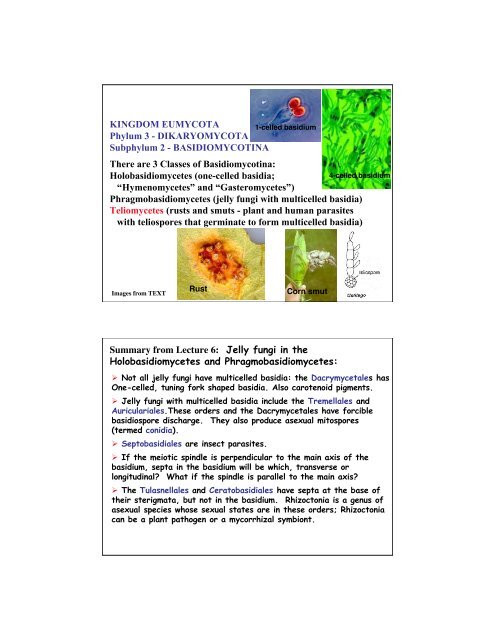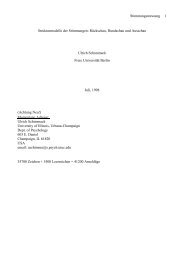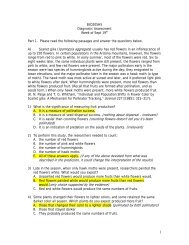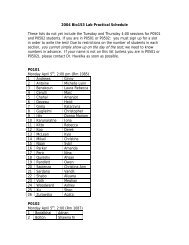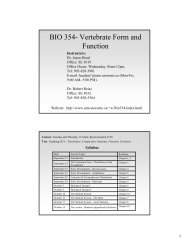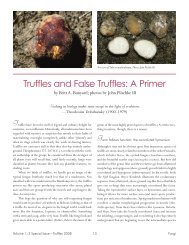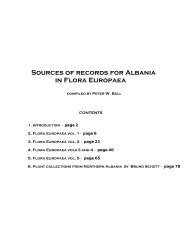KINGDOM EUMYCOTA Phylum 3 - DIKARYOMYCOTA Subphylum ...
KINGDOM EUMYCOTA Phylum 3 - DIKARYOMYCOTA Subphylum ...
KINGDOM EUMYCOTA Phylum 3 - DIKARYOMYCOTA Subphylum ...
Create successful ePaper yourself
Turn your PDF publications into a flip-book with our unique Google optimized e-Paper software.
<strong>KINGDOM</strong> <strong>EUMYCOTA</strong><br />
<strong>Phylum</strong> 3 - <strong>DIKARYOMYCOTA</strong><br />
<strong>Subphylum</strong> 2 - BASIDIOMYCOTINA<br />
There are 3 Classes of Basidiomycotina:<br />
Holobasidiomycetes (one-celled basidia;<br />
“Hymenomycetes” and “Gasteromycetes”)<br />
Phragmobasidiomycetes (jelly fungi with multicelled basidia)<br />
Teliomycetes (rusts and smuts - plant and human parasites<br />
with teliospores that germinate to form multicelled basidia)<br />
Images from TEXT<br />
1-celled basidium<br />
Rust Corn smut<br />
Summary from Lecture 6: Jelly fungi in the<br />
Holobasidiomycetes and Phragmobasidiomycetes:<br />
4-celled basidium<br />
Not all jelly fungi have multicelled basidia: the Dacrymycetales has<br />
One-celled, tuning fork shaped basidia. Also carotenoid pigments.<br />
Jelly fungi with multicelled basidia include the Tremellales and<br />
Auriculariales.These orders and the Dacrymycetales have forcible<br />
basidiospore discharge. They also produce asexual mitospores<br />
(termed conidia).<br />
Septobasidiales are insect parasites.<br />
If the meiotic spindle is perpendicular to the main axis of the<br />
basidium, septa in the basidium will be which, transverse or<br />
longitudinal? What if the spindle is parallel to the main axis?<br />
The Tulasnellales and Ceratobasidiales have septa at the base of<br />
their sterigmata, but not in the basidium. Rhizoctonia is a genus of<br />
asexual species whose sexual states are in these orders; Rhizoctonia<br />
can be a plant pathogen or a mycorrhizal symbiont.
Lecture 7: Teliomycetes I– Smuts<br />
Reading: Text, Chapter 5, http://tolweb.org/Basidiomycota/20520<br />
And http://tolweb.org/Ustilaginomycotina/20530<br />
Objectives: Ustilaginales (class Teliomycetes). Know what a teliospore<br />
is. Interpret the relationship between haploid yeast, dikaryotic<br />
mycelial and teliospore forms of smut with phases in the disease<br />
process<br />
Corn smut Teliospores<br />
http://tolweb.org/tree?group=Basidiomycota&contgroup=Fungi<br />
Exobasidium forms no fruitbodies<br />
http://tolweb.org/Ustilaginomycotina/20530<br />
The Ustilaginomycetes (1400 species in 70<br />
genera) are ecologically characterized by<br />
being parasites of vascular plants.<br />
None parasitize orchids – a family with<br />
20,000 species.<br />
Features of the Ustilaginomycetes:<br />
Plant parasitism – with cellular interaction by means of interactive vesicles,<br />
Cell wall carbohydrate composition - dominance of glucose and no xylose,<br />
5S rRNA secondary structure of type B,<br />
Septal pores without parenthesomes, but with 3-part membrane caps,<br />
Life cycle with parasitic dikaryon phase and a saprophytic haploid phase.
3 characteristics of Ustilaginales (= Ustilaginomycetes):(1) haustoria<br />
and interactive vesicles; (2) simple septum with 2 caps; (3) saprobicparasitic<br />
alternation in life cycle.<br />
Primary interactive vesicles.<br />
Scale bar = 0.2 µm.<br />
Type 1<br />
long n+n phase.<br />
Typical for<br />
Basidiomycetes.<br />
local interaction zone (arrows)<br />
between fungus (lower cell) and its<br />
host (upper cell). Interaction<br />
structure(arrows) and deposit at host<br />
cell. Scale = 0.5 µm.<br />
Generalized life cycle of the Ustilaginomycetes.<br />
© R. Bauer and F. Oberwinkler 1997<br />
http://www.botany.hawaii.edu/faculty/wong/Bot201/Basi<br />
diomycota/Ustomycetes/Ustomycetes.htm<br />
http://botit.botany.wisc.edu/toms_fungi/march98.html<br />
Enlarged interaction zone<br />
between enlarged interaction<br />
zone between fungus and<br />
host. Haustorium (h).<br />
Scale = 2 µm<br />
http://tolweb.org/tree?group=Ustilaginomycetes&contgroup=Basidiomycota#cycle<br />
Transmission electron micrograph<br />
showing Ustilaginomycetes simple<br />
septal pore with two membrane caps.<br />
Scale = 0.1 µm. © R. Bauer 1997<br />
Symptom of corn smut is “tumor” - each ovary of female flower<br />
(collectively comprising the corn “cob” or “ear” undergoes increase in<br />
both cell size and cell number, termed hyperplasia.
Ustilago maydis (corn smut) shows an alternation between a saprophytic<br />
yeast phase and a parasitic (obligately!) filamentous phase.<br />
Casselton, LA and Olesnickcy, NS 1998 Microbiology and Molecular Biology Reviews 62: 55-70.
Key points:<br />
-Corn smut is caused by Ustilago maydis<br />
-A promycelium = a 4 celled smut basidium<br />
-The monokaryon is a haploid saprophyte yeast<br />
(yeast cells are here called sporidia).<br />
-Not until mating and the formation of dikaryon<br />
does this fungus become a obligate parasite on<br />
corn. There are 2 mating type loci, each with<br />
different “jobs”.<br />
-Dimorphism means two forms: yeast + hyphae<br />
-The haploid dikaryon is the obligate, biotrophic<br />
parasitic phase. It is filamentous hyphae.<br />
- To reproduce, a diploid forms that in turn<br />
forms teliospores.<br />
-Teliospores form basidia (= promycelia).<br />
Switch from saprophytic growth by budding to<br />
filamentous and pathogenic development<br />
regulated by the multi-allelic b-mating type locus<br />
that encodes 2 unrelated homeodomain proteins<br />
bE and bW. The combination of the alleles forms<br />
heterodimer that controls pathogenicity genes as<br />
a transcriptional regulator.<br />
- Bolker M. 2001. Microbiology 147:1395-1401.<br />
- Steinberg, G. and Perez-Martin, J. (2008) Ustilago<br />
maydis, a new fungal model system for cell biology.<br />
Trends Cell Biol., 18, 61-67.
Microbotryum, which causes anther smut disease on<br />
members of the plant family Caryophyllaceae.<br />
http://www.people.virginia.edu/%7Emeh2s/labhome/idnp.htm<br />
Janis Antonovics<br />
Anther smut as a sexual disease:<br />
•Epidemiology, e.g short and long term dynamics<br />
•Host shifts<br />
•Virulence, e.g.,Multiple infections and competition on a single plant<br />
•Think about the plant equivalent of social systems, mating systems, and habitat use.<br />
Text recognizes two families in the Ustilaginales in class<br />
Teliomycetes, Ustilaginaceae and Tilletiaceae; based on DNA, the Tree<br />
of Life puts these families in two different classes of phylum<br />
Ustilaginomycotina<br />
Family Tilletiaceae. karyogamy, meiosis and mitosis all happen inside the teliospore.<br />
Resulting basidium produces a cluster of slender, parallel basidiospores from its apex.<br />
These soon copulate in pairs to restore the dikaryon.<br />
Tilletia caries, the cause of `bunt' or stinking smut of wheat, is just as important an<br />
economic problem as stem rust, because it has so far proved impossible to breed strains of<br />
wheat resistant to this fungus.<br />
Symptoms of Karnal Bunt (Tilletia indica)<br />
Infection on wheat seed.<br />
This disease was first noted in India, then Iraq, Nepal, Pakistan, Afghanstan, introduced<br />
to Mexico, now is in SW USA.<br />
Major trade issue for US export of wheat. (Quarantines/trade restrictions have been<br />
costly and controversial.<br />
1. Healthy wheat seed. 2. "Tip" infection. 3. More advanced tip infection. 4. Advanced infection.<br />
5. "Canoe" symptom hollowing out interrior of seed. – Infected wheat stinks and cannot be used for<br />
flour! http://www.aphis.usda.gov/oa/pubs/karnel.html<br />
http://tolweb.org/Ustilaginomycotina/20530


